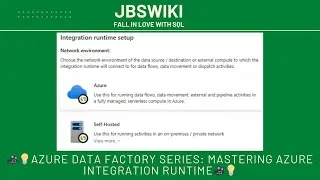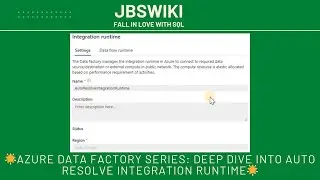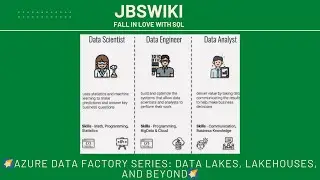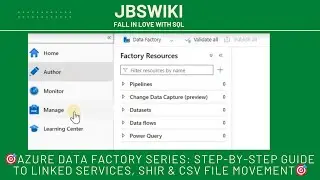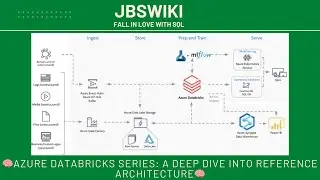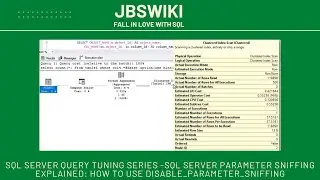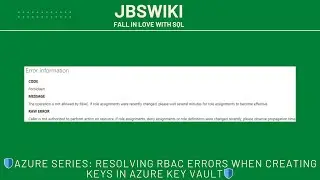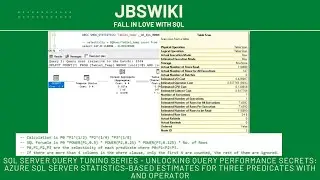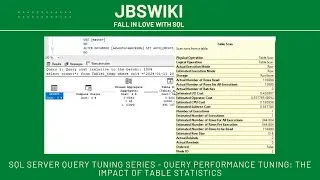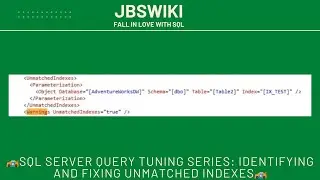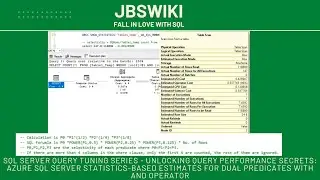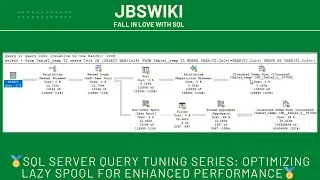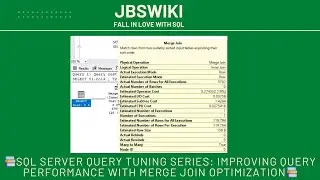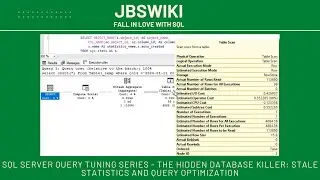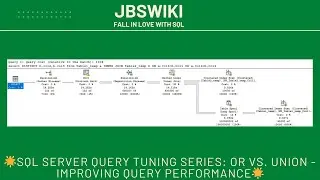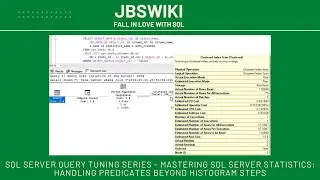SQL Server Query Tuning Series - SQL Server Query Tuning: Optimizing Stored Procedure Estimations
SQL Server Query Tuning Series - SQL Server Query Tuning: Optimizing Stored Procedure Estimations @jbswiki #SQL Server Query Tuning
Welcome, SQL Server enthusiasts, to an extensive journey into the intricate world of database performance optimization. In this comprehensive video, we're going to delve deep into SQL Server query optimization, with a laser focus on how the SQL Server optimizer estimates execution plans for stored procedures.
Performance is the lifeblood of any database-driven application. Whether you're managing a small-scale web application or an enterprise-level data warehouse, how efficiently your stored procedures execute can have a profound impact on your system's overall performance and user experience.
In this video, we'll leave no stone unturned. We'll explore the very core of SQL Server's query optimization process, unraveling the mysteries behind how the optimizer decides the best way to execute your stored procedures. But we won't stop there. We'll introduce you to a powerful tool, DBCC SHOW_STATISTICS, which will enable you to gain deep insights into your data's organization.
By the time we're done, you'll have the knowledge and tools to take your stored procedure optimization skills to the next level. Whether you're a seasoned database administrator (DBA), a developer keen on optimizing your code, or simply a curious learner eager to peer behind the curtain of SQL Server's inner workings, this video has something for you.
Join us as we embark on this exciting journey to demystify SQL Server query optimization for stored procedures. We'll unlock secrets, dispel myths, and arm you with the skills necessary to supercharge your database's performance. Get ready to dive deep into "SQL Server Query Tuning: Optimizing Stored Procedure Estimations."
Understanding SQL Server Query Optimization
Before we dive into the details of stored procedure estimations, let's lay a solid foundation by understanding the SQL Server Query Optimizer and its role in optimizing query execution. The SQL Server Query Optimizer is a complex component responsible for generating efficient query execution plans. Its goal is to find the optimal path to retrieve and manipulate data from your database.
Factors Affecting Estimations
The accuracy of the Query Optimizer's estimations depends on various factors. In this section, we'll delve into these key factors and their impact on estimation accuracy. Some of the primary factors include:
Table Statistics: We'll discuss the importance of statistics on table data distribution, index usage, and how they help the optimizer make informed decisions.
Indexes: Indexes play a vital role in optimizing queries. We'll explore different types of indexes and how they influence estimations.
Query Complexity: Complex queries can be challenging for the optimizer to estimate accurately. We'll examine how the complexity of your SQL statements affects estimation accuracy.
By understanding these factors, you'll gain insights into why estimations are essential and how they shape the execution plans chosen by the Query Optimizer.
DBCC SHOW_STATISTICS: A Deep Dive
To gain a deeper understanding of estimations, we need to explore a powerful tool at our disposal—DBCC SHOW_STATISTICS. This command provides detailed statistics about tables and indexes, giving us invaluable insights into the data distribution and index usage.
The Estimation Process for Stored Procedures
Now that we have a solid foundation in SQL Server query optimization and statistics, let's dive into the estimation process specific to stored procedures. When you execute a stored procedure, the Query Optimizer needs to estimate the best execution plan for it.
Common Estimation Errors and Solutions
Even with all the knowledge and tools at its disposal, the Query Optimizer can sometimes make incorrect estimations, leading to suboptimal execution plans. In this section, we'll explore common estimation errors and provide practical solutions for addressing them.
Some of the common estimation errors we'll cover include:
Outdated Statistics: What happens when your statistics are out of date, and how to keep them up to date.
Parameter Sniffing: Understanding the parameter sniffing problem and techniques to mitigate it.
Data Skew: How data distribution imbalances can affect estimations and strategies to handle data skew.
By learning to recognize and rectify these estimation errors, you'll be well-equipped to optimize your stored procedures and ensure your SQL Server performs at its best.
Conclusion
In this extensive exploration of SQL Server query optimization, we've gone from understanding the basics of the SQL Server Query Optimizer to mastering the art of optimizing stored procedure estimations. We've learned how to use DBCC SHOW_STATISTICS to gain insights into our data, explored the estimation process, and discussed common estimation errors and their solutions.









